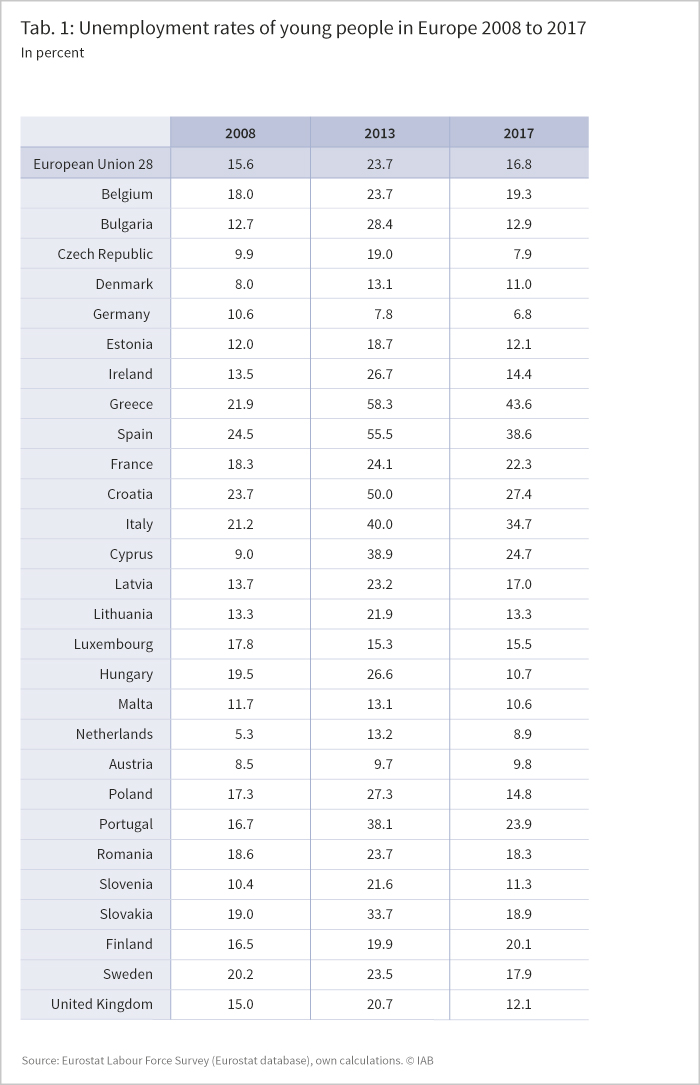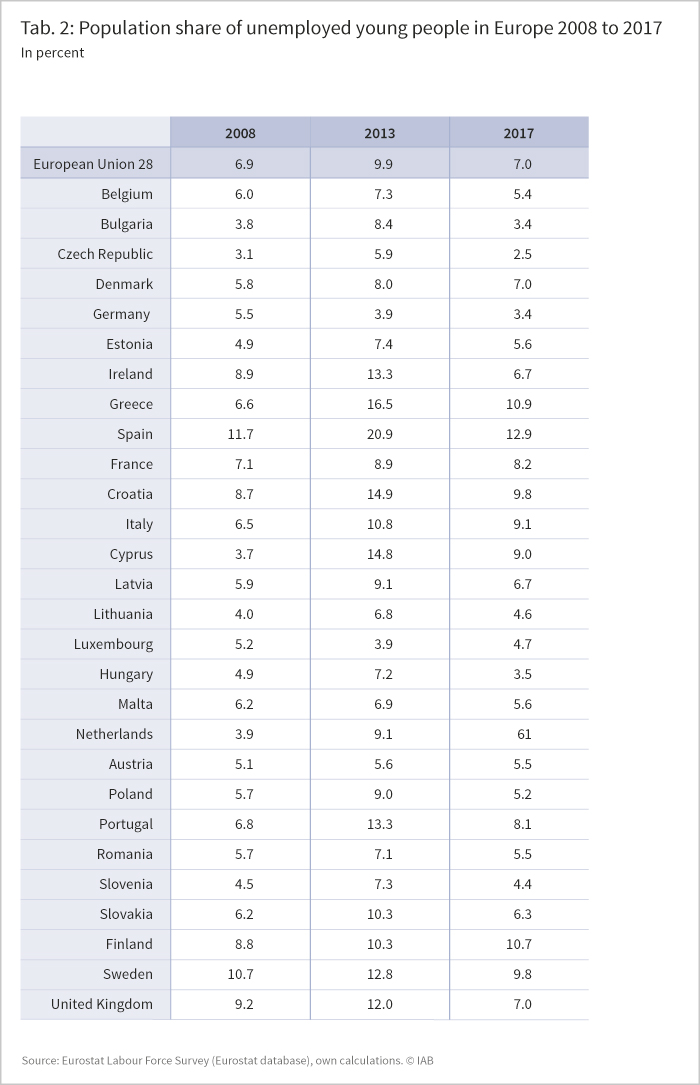2. July 2018 | International Labour Markets
European youth unemployment in the aftermath of the Great Recession

A range of scientific studies indicate that long periods of unemployment during the critical transition from school to work can have particularly negative impacts on long-term career trajectories: including on labour-force participation, the quality of employment, and on income. Accordingly, high rates of youth unemployment in Europe are given high political priority, as well as being a key focus of public debate.
Youth unemployment rate in Europe
In the public discussion particular attention is drawn to the so-called unemployment rate. For the European member states Eurostat reported a youth unemployment rate of 15.6 percent in 2008, the year before the Great Recession hit in most European countries. The rate reached its EU peak of 23.7 percent in 2013. Till 2017, the overall EU youth unemployment rate recovered to 16.8 percent; close to the pre-recession level. A number of Mediterranean countries were particularly affected by the increase in the youth unemployment rate (notably Greece, Spain, Italy and Portugal), but additionally some other countries like Ireland or Croatia experienced a more than 100 percent increase of the youth unemployment rate during the great recession. Improvements in the situation can be observed in most of the countries which were badly affected by the recession since 2013. Thus, the unemployment rate of young people in Greece fell from 58.3 percent in 2013 to 43.6 percent in 2017; and from 55.5 percent in Spain in 2013, to 38.6 percent in 2017 (see Table 1). By contrast, in some European countries with low levels of youth unemployment rates, we observe now a slower recovery (Denmark or France) or even a slight increase of the youth unemployment rate since 2013 (Austria, Finland, or Luxembourg) (see Table 1).

How to measure youth unemployment
However, it should be noted that using the unemployment rate as an indicator tends to overestimate the phenomenon of youth unemployment. Young people who, for example, are at school, studying or who are unavailable to the labour market for other reasons are not taken into account under this metric. The denominator, consisting of unemployed and gainfully employed people, is thus systematically smaller than in other age groups, and even the presence of relatively few unemployed young people in the denominator can make the rate seem very high. Especially comparisons of youth unemployment rates between countries suffer from these effects, as the share of inactive young people, mainly participating at education or training substantially varies across European countries. Thus, comparisons of young people’s social situation across different countries should favour the proportion of unemployed young people as a share of the total population within the given age range, as shown by Hans Dietrich in his 2015 study. The values for this indicator come out as significantly smaller compared to the youth unemployment rate (see Table 2). The population share of unemployed young people in the EU was therefore at 6.9 percent at the start of the recession in 2008; rising to 9.9 percent in 2013; and then, in the wake of the recovery, dropping to 7 percent in 2017. Again, the recovery differs across European countries. Whilst in the majority of countries the population share in 2017 is close to that of 2008 or even below, in some other counties the level is still higher, like France, Austria or Finland. Regarding the countries most affected by the great recession, Ireland and Spain have recovered quite well whilst Italy, Greece and Portugal are still significantly above the 2008 threshold (see Table 2).

Unemployment among young people compared to the elder age group
Compared to adults aged 25 to 64, the risk of unemployment amongst young people (15-24 years) is significantly higher. Contributing factors include the particular circumstances surrounding the transition from school/ education into the labour market. Job-search periods after graduation, lack of work experience, insecure contracts (fixed-term contracts or marginal contracts when first starting work) all increase the risk of temporary and possibly repeated unemployment in this phase of an individual’s career trajectory as shown by Hans Dietrich’s and Joachim Möller’s 2015 study. In addition, country-specific factors should be considered. These include demographic factors (birth rate, mortality and migration) and in particular the strength of the economy, which, alongside an individual’s own characteristics have a considerable influence on a person’s risk of becoming unemployed as the analysis in 2015 by Hans Dietrich and Joachim Möller shows.
For example, Eurostat reports an adult unemployment rate of 8.4 percent for 2015, compared to 20.4 percent for young people. This corresponds to a ratio of 1:2.4. In this regard, Germany has occupied a rather exceptional position: until the beginning of the 2000s, the ratio was almost 1:1. Since then, the German ratio has been tending towards the European level, although a clear discrepancy still exists. This relative deterioration in the labour-market position of young people in Germany went largely unnoticed because youth unemployment had been declining for years and was very low in international comparison. Nevertheless, this development should give food for thought because it highlights the existence of factors in Germany which make entering the job market increasingly difficult for young people.
Young migrants particularly hard hit by the recession
Even before the Great Recession foreign-born young people bore a higher risk of becoming unemployed than native young people in most European Member States. With the onset of the recession, the share of unemployed foreigners rose disproportionately until 2013. With the onset of recovery, not only did the unemployment rate of foreign young people decline, but the distance to the quota of native-born young people also decreased.
Contrary to this trend, the unemployment rate of foreign young people has recently been increasing in Germany or Austria. A contributing factor to this trend was the arrival of young migrants and refugees in these countries in recent years.
Duration of young people’s unemployment
In the wake of the Great Recession, not only has the number and proportion of unemployed young people clearly increased, but also the duration of the young person’s period of unemployment. Thus, the percentage of young people who were unemployed for longer than six months had been declining until the onset of the recession, and rose significantly across the EU thereafter, reaching a peak in 2014. Since 2014 the trend has changed and the share of long term unemployed young people experienced a significant reduction in the average duration of unemployment in Europe. To a different extent the picture holds for most of the European countries. Nevertheless, close to one in two unemployed young people in Europe are still unemployed for more than six months, whilst in Greece or Italy it is two out of three.
In relation to the duration of youth unemployment Germany also occupies an unusual position. Here, the average duration of unemployment amongst young people has been declining since 2005. Whilst the Federal Republic shows a very low level of youth unemployment rate in international comparisons, the duration of unemployment of young people does not compare as positively as the unemployment rate. Thus, in Germany about four in ten unemployed young people are out of work for more than half a year (based on self-reporting data). In Denmark and Sweden, this proportion is just under a quarter. Compared to unemployed people aged over 25 years however, unemployed young people are on average out of work for shorter periods, as the job market for young people proves to be significantly more dynamic overall.
Conclusions
Within the last few years in particular, we observe a sharp reduction of youth unemployment in Europe – measured both in terms of youth unemployment rate and population rates. However, the dynamic differs across European countries. In most recent years, even countries severely affected by the Great Recession, like Ireland or the Baltic States, have improved remarkably, whilst other countries like the Mediterranean countries have improved, but still report high unemployment rates, especially youth unemployment rates. By contrast, we still observe long durations of individual unemployment, even if the overall duration of unemployment in the youth age group has reduced significantly in recent years. Additionally, we have to take processes into account which are more or less unrelated to the Great Recession. The dramatic increase of international migration and the arrival of refugees in European countries, where young people are highly overrepresented, indicate a new perspective on the European youth unemployment debate. These young people will require access both to education and to the labour market. The prevention and reduction of long-term unemployment and the integration of young migrants will shape European and country specific politics in the coming years, and require appropriate measures for tackling them.
Literature
Dietrich, Hans (2013): Youth unemployment in the period 2001–2010 and the European crisis – looking at the empirical evidence. In: Transfer: European Review of Labour and Research 19(3), pp. 305 – 324.
Dietrich, Hans (2015): Jugendarbeitslosigkeit aus einer europäischen Perspektive. Theoretische Ansätze, empirische Konzepte und ausgewählte Befunde. IAB-Discussion Paper, 24/2015, Nürnberg.
Dietrich, Hans; Möller, Joachim (2015): Youth Unemployment in Europe – Business Cycle and Institutional Effects. In: International Economics and Economic Policy 13(1), pp. 5-25. DOI: 10.1007/s10368-015-0331-1.
Dietrich, Hans (2018): Erwerbsarbeit und Arbeitslosigkeit Jugendlicher. In: Andreas Lange; Christine Steiner; Sabina Schutter & Herwig Reiter (eds): Handbuch Kindheits- und Jugendsoziologie, Springer, pp. 205-239.
Dietrich, Hans; Annie Tubadji; Brigitte Schels; Anette Haas; Ioanna Tsoka; Vasilis Angelis; Katerina Dimaki (2018): Youth unemployment and the transition from school to work in Germany and Greece. In: Floro Ernesto Caroleo, Olga Demidova, Enrico Marelli, Marcello Signorelli (eds): Young people and the labour market. A comparative perspective, Abingdon/New York: Routhledge , pp. 127-157.
Dietrich, Hans (2018): European youth unemployment in the aftermath of the Great Recession, In: IAB-Forum 2nd of July 2018, https://www.iab-forum.de/en/european-youth-unemployment-in-the-aftermath-of-the-great-recession/, Retrieved: 20th of April 2024
Authors:
- Hans Dietrich

 Dr Hans Dietrich is a senior researcher in the department "Education, Training, and Employment Over the Life Course" at the IAB.
Dr Hans Dietrich is a senior researcher in the department "Education, Training, and Employment Over the Life Course" at the IAB.